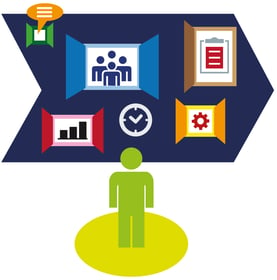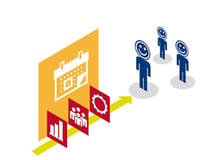What Should Your Supply Chain Dashboard Look Like?
Brian Hoey - January 09, 2020

 We all have different ways of getting a handle on our supply chain activity. Some folks might check a series of KPIs every morning to see what small fluctuations in supply and demand have occurred overnight, while others might be more interested in the big picture, seeking out a comprehensive visualization of the supply chain at the end of every month. However you like to think about and analyze your supply chain data, your routine probably revolves around a dashboard.
We all have different ways of getting a handle on our supply chain activity. Some folks might check a series of KPIs every morning to see what small fluctuations in supply and demand have occurred overnight, while others might be more interested in the big picture, seeking out a comprehensive visualization of the supply chain at the end of every month. However you like to think about and analyze your supply chain data, your routine probably revolves around a dashboard.
As supply chain management has become increasingly digitized and planners have become more reliant on computers for understanding conditions and developing plans, the supply chain dashboard has become a critical piece of the planning and management puzzle for manufacturers and logistics providers. This is powered in part by the rise of the internet of things (IoT), which has resulted in new digital data streams that can help inform decision-making, but it’s also a function of increased software integration within and outside of supply chain businesses. Since the trend is towards more data and more analysis, a poorly structured dashboard can become overwhelming and hard to read pretty quickly—which is why it’s so important to have a clear picture of what you want your dashboard to look like.
To that end, here are a few tips for creating the most valuable supply chain dashboard.
The Importance of Flexibility
Later in the piece, we’ll spend some time talking about the particular KPIs you might be interested in visualizing. But for starters, we'd like to emphasize a broader principle: the importance of flexibility. Whatever metrics and sources of data your dashboard is designed to display, gaining the answers and insights you need is going to depend on your ability to change your parameters and pose different scenarios as you go. Let’s say, for instance, that you want to see individual plant and line utilization for the projected future. To figure out the best way to optimize that utilization, you’ll want to see both the near term (i.e. the coming days or weeks) and the longest term for which you have orders. As you make potential parameter changes and introduce new planning variables into the equation, it’s crucial to be able to visualize the effect across different time frames—otherwise you’ll be making your decisions based on incomplete information.
By the same logic, if you’re running a plant that produces multiple different products in varying ratios, you should be able to break down demand levels for different products on a granular basis. You really shouldn’t have to run a new report or navigate to a different part of your software to compare demand seasonality for one product versus your entire portfolio, for instance. Ultimately, the more barriers there to accessing necessary information quickly and easily, the less likely planners are to get the full picture before they make a decision. This can result in disruptions and other issues down the road.
(Nota bene: because adjusting your parameters and getting new data quickly is of paramount importance, it’s worth thinking about the use of in-memory technology for powering your dashboard. In-memory is essentially a way of keeping relevant data cached so that your dashboard can create visualizations more quickly.)
Choosing the Right KPIs
Okay, we’ve talked about the ways that you can and should think of your supply chain dashboard, but what information and KPIs should you actually track? For starters, there’s some concrete information you’re often going to want:
- Existing orders
- Existing capacity by plant
- Logistics capacity over time
- Capacity utilization
- Resources on-hand
- Supplier resources on-hand
This last item might require some IT integration between you and your suppliers, but it fits into the general trend in which your starting point is a snapshot of “official” demand and capacity levels. From there, you can begin to incorporate projections and other second order metrics.
- Demand forecasts projecting future orders
- Financial forecasts dealing with changing production costs
- Production and logistics planning scenarios based on changing parameters
Essentially, the first set of visualizations exist to give you a sense of your resources as they currently exist, and the second set projects those resources into future operations and market conditions. If, by way of illustration, we think of supply chain management like a game of chess, your dashboard should first show you where all of the pieces currently are—and, with that established, it should also help you to think three moves ahead by showing you likely outcomes for particular choices.
What If?
Once you’ve figured the KPIs that are most important to you and gained a sense of how they can be flexibly manipulated to help you make short, medium, and long term tactical and strategic decisions, it’s time to ask yourself what comes next. What other workflows will your dashboards help you to support and empower? Well, once you’ve got the relevant data feeds hooked up to one another in way that can power accurate forecasts and provide up-to-date or even real-time supply chain information, it might be time to branch out into something a little more creative. To that end, you might integrate your dashboards with sandboxes or “What-if” scenarios.
These are both, essentially, ways to simulate the functioning of your entire S&OP flow by creating a separate but identical digital copy of your production or transport network. Using one of these “digital twins,” you can test out the projected outcomes of any decisions that you might be considering. Considering removing a cross-dock from your network? Your advanced analytics can run the scenario and let you know how it impacts your existing workflows. Thinking about decreasing your inventory square footage to try and get more agile? The what-if scenario can help you understand whether or not it’s a good idea from an ROI perspective. While you might not utilize these every day the way you would for your standard dashboard, they’re a logical extension of the activity that makes the dashboards useful in the first place. What activity is that, exactly? The continual attempt at matching up expectations, hypotheses, and reality.
LATEST POSTS
- Understand Circular Economy in The Manufacturing Industry
- How Can Industry 4.0 IT Integration Be Achieved Smoothly?
- The Significance of Order Sequencing in Discrete Manufacturing
- How to improve your Supply Chain Management: The Power of Control Towers
- Optimizing Human Resource Scheduling in Manufacturing: A Technological Approach



